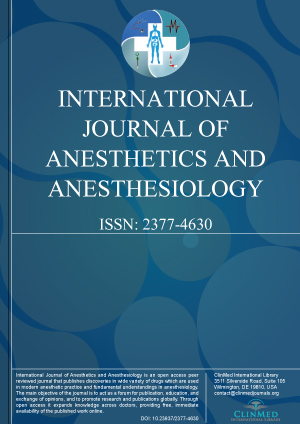Open Access DOI:10.23937/2377-4630/1011
Six Month Quality of Life of Trauma Patients from A Non- Trauma Regional Hospital in Singapore
Shahla Siddiqui, Lim WoanWui and Koh Kwong Fah
Article Type: Case Report | First Published: October 27, 2014
Introduction: Trauma is a leading cause of mortality and morbidity in Singapore. In our peripheral hospital we have a large trauma load despite being a non level one trauma center. Whilst we have many studies done in the West documenting the quality of life of trauma victims using scoring systems such as the EQ5DTM and GOSE, there is a paucity of literature from this part of the World.
Methods: We analyzed the results of 6 months of data collected by our trauma coordinator looking specifially ...
Open Access DOI:10.23937/2377-4630/1010
What Happens if The Patient Does Not Tell the Truth to His Anesthesiologist?
Alev Oztas, Ezgi Erkilic, Elvin Kesimci, İbrahim Keser and Duran Canatan
Article Type: Case Report | First Published: October 20, 2014
This is the case report of a young man, whose clinical condition has not been identified properly in the preoperative evaluation. A 27-yr-old man presented with complaints of nasal obstruction. His clinical examination was almost unremarkable, except for indistinct cyanosis at the lips. He denied any symptoms related cardiovascular and respiratory systems. A chest radiograph was normal, as were all laboratory investigations. He had received general anesthesia with persistent low pulse oximetry r...
Open Access DOI:10.23937/2377-4630/1009
Platelet Count and INR Profile after Hepatic Resection in Cirrhotic Patients: Implications for Epidural Analgesia
Siniscalchi A, Gamberini L, Carini A, Laici C, Tassinari S and Faenza S
Article Type: Original Article | First Published: October 15, 2014
Introduction: Since cirrhotic patients undergoing hepatic resection are at increased risk of developing postoperative coagulopathy, epidural catheter placement in this group of patients is still debated. This retrospective study aimed to evaluate postoperative course of coagulation parameters after surgical hepatic resection in cirrhotic patients and their relation to extent of resection and perioperative risk factors.
Methods: Perioperative data from 232 hepatic resections performed in cirrho...
Open Access DOI:10.23937/2377-4630/1008
Is Left Ventricular Hypertrophy Early Regression Possible?
Delgado-Baeza Emilio, Quintana-Villamandos Begona
Article Type: Editorial | First Published: September 30, 2014
It is well established that hypertension is associated with increased cardiovascular morbidity and mortality. Left Ventricular Hypertrophy (LVH) is a relevant problem in patients with hypertension because of its role in long-term severe cardiovascular diseases, including ventricular arrhythmia, congestive heart failure, myocardial infarction, stroke and sudden death. There is a relationship between the regression of LVH and a decreased morbidity and mortality. Treatment to achieve regression of ...
Open Access DOI:10.23937/2377-4630/1007
Airway Management in a Patient with Metatropic Dysplasia: Grossly Abnormal Anatomy Combined with a Low Functional Residual Capacity
Joseph G. Werner, Alberto A. Uribe, Karina Castellon-Larios, Sergio D. Bergese and Matthew P. McKierna
Article Type: Case Report | First Published: September 29, 2014
Difficult intubation is a constant concern in surgical and critical care settings due to its direct relationship with morbidity and mortality. The incidence reported in literature varies between 0.1% to 13% and reaches 14% in the obese population. The American Society of Anesthesiologists (ASA) defined difficult airway as a situation in which a trained anesthesiologist experiences difficulty with facemask ventilation of the upper airway, difficulty with tracheal intubation, or both. They also de...
Open Access DOI:10.23937/2377-4630/1004
Intrathecal Dexmedetomidine or Meperidine for Post-spinal Shivering
Mohamed Hamdy Ellakany
Article Type: Research Article | First Published: September 11, 2014
Background: Shivering occurs frequently during the perioperative period. A prospective, randomized, double-blind study was done to compare between intrathecal dexmedetomidine (5mcg) and intrathecal meperidine (0.2mg/kg) for decreasing the incidence and intensity of shivering after spinal anesthesia for lower abdominal operations.
Methods: Seventy five patients scheduled for lower abdominal operations under spinal anesthesia were randomly allocated to three groups. Spinal anesthesia consisted o...
Open Access DOI:10.23937/2377-4630/1005
Anaesthetic Management in a Patient with Glomus Jugulare Tumour for Ankle Surgery
Monu Yadav, R Gopinath, B Rajesh Kumar, Shibani Padhy, A Anand Ram and Suresh Kumar Chintha
Article Type: Case Report | First Published: September 11, 2014
Anaesthesia has special considerations in any case of intracranial space occupying lesions. Not much of literature is available about anaesthetic considerations in a patient with Glomus jugulare tumour requiring surgery for non neurosurgical procedure. Glomus jugulare tumours arise from the glomus body within the adventitia of the jugular bulb. Glomus bodies are histologically similar to carotid bodies. They are composed of epitheloid cells embedded in capillary net work. Occasionally these tumo...

